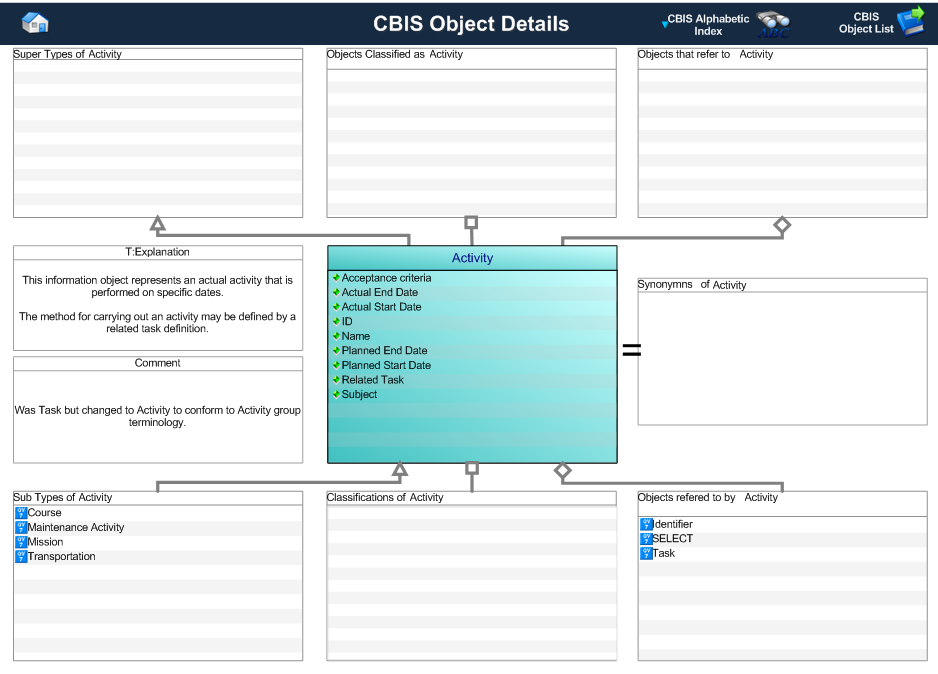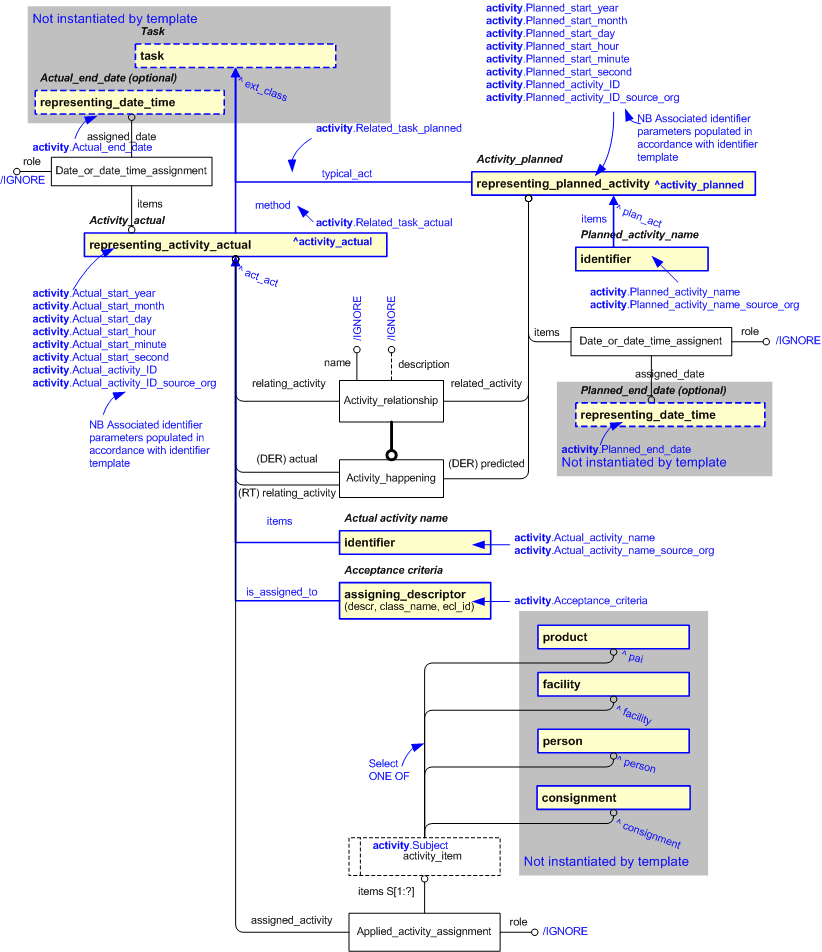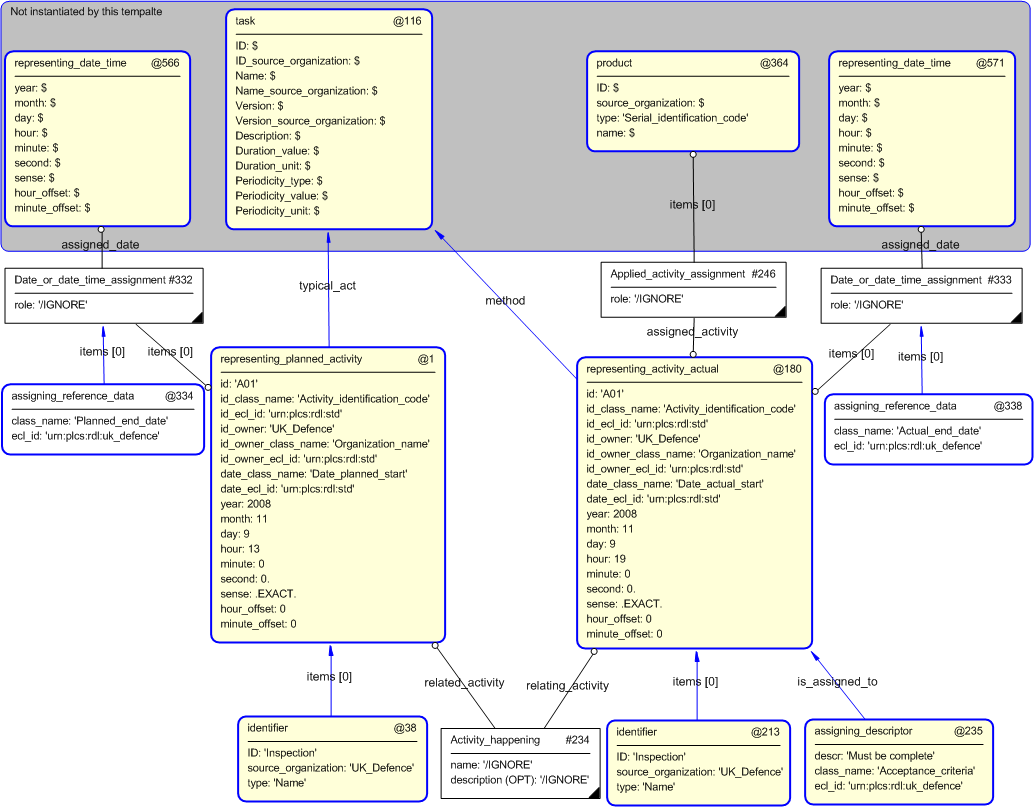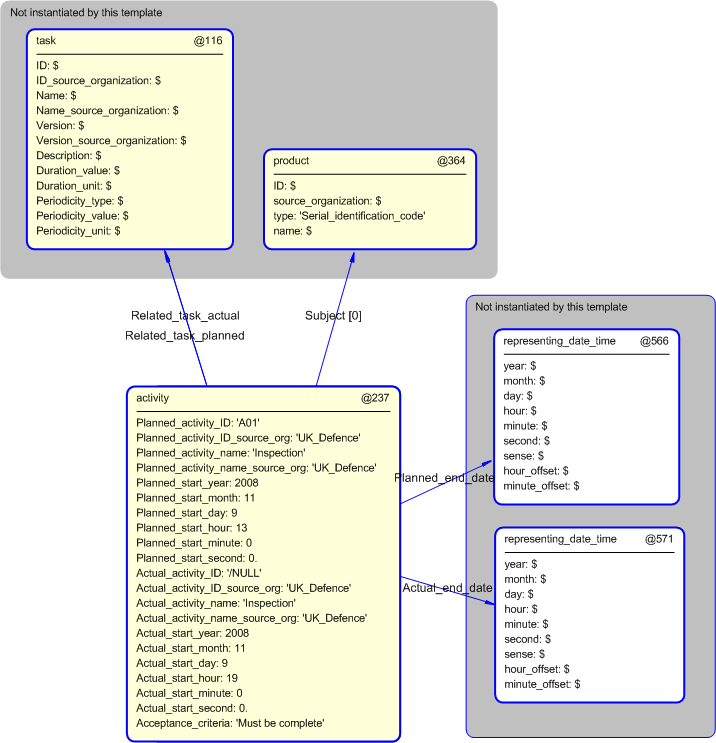Template:— activity (act)
Context:— UK_Defence |
Date: 2009/12/11 19:31:31
Revision: 1.7
|
This section specifies the template activity.
NOTE
The template has been defined in the context of
UK_Defence.
Refer to the business context for details of related templates.
NOTE
An explanation of a template and the associated instantiation path is
provided in the
Template overview
section.
This template describes how to represent the actual procedures, defined in a Task, that are performed on one or more items.
The Activity business object is used by those UK_Defence Data Exchange
Specifications that require information about actual activities .
Figure 1 — Graphical Representation for Business Object Activity
Activity:
The definition of an Activity object is:
Data about a activities that is intended to be communicated between people / organizations.
|
Attribute name
|
Attribute description
|
Attribute type
|
Optionality
|
| Acceptance Criteria |
This is the acceptance criterium for the actual activity. |
Intrinsic |
Mandatory |
| Actual End Date |
This is the date on which the Activity finishes. |
Relationship to Date-time |
Optional |
| Actual Start Date |
This is the date on which the Activity begins. |
Intrinsic |
Mandatory |
| ID |
This is the Identifier of the Activity. |
Identifier |
Mandatory |
| Name |
This is the name of the Activity. |
Intrinsic |
Mandatory |
| Planned End Date |
This is the date by which the Activity is intended to be finished. |
Relationship to Date-time |
Optional |
| Planned Start Date |
This is the date on which the Activity is intended to start. |
Intrinsic |
Mandatory |
| Related Task |
This is the Task that defines the Activity. |
Relationship to Task |
Optional |
| Subject |
This is the reference to the object on which the activity is performed. |
Select relationship to Product, Facility, Person, or Consignment. |
Mandatory |
Table 1 — Activity attribute details
The EXPRESS-G diagram in
Figure
2
shows the templates and EXPRESS entities that are required
to represent the template
"activity".
The text highlighted in blue shows the template parameters.
Figure 2 — An EXPRESS-G representation of the Information model for activity
The graphic for the template to be used in other EXPRESS-G diagrams
is shown in Figure
3
below.
Note that the optional related task is split to cater for both a 'planned' task and an 'actual' task.
Figure 3 — The graphical representation of the activity template
The following input parameters are defined for this template:
The identifier of the planned activity.
The identifier of the organization that is the source of the identifier of the planned activity.
The name of the planned activity.
The identifier of the organization that is the source of the name.
The year component of the date and time the activity is planned to start.
The month component of the date and time the activity is planned to start.
The day component of the date and time the activity is planned to start.
The hour component of the date and time the activity is planned to start.
The minute component of the date and time the activity is planned to start.
This parameter is optional. If not given, it will remain unset.
The second component of the date and time the activity activity is planned to start.
This parameter is optional. If not given, it will remain unset.
The task that defines the planned activity.
The identifier of the actual activity.
The identifier of the organization that is the source of the identifier.
The name of the actual activity.
The identifier of the organization that is the source of the name.
The year component of the date and time the activity was started.
The month component of the date and time the activity was started.
The day component of the date and time the activity was started.
The hour component of the date and time the activity was started.
The minute component of the date and time the activity was started.
This parameter is optional. If not given, it will remain unset.
The second component of the date and time the activity was completed.
This parameter is optional. If not given, it will remain unset.
The task that defines the actual activity.
The acceptance criterion for the actual activity.
The object on which the activity is performed.
This is the date on which the activity was planned to end.
This is the date on which the activity actually ended.
The following reference parameters are defined for this template:
Allow the
Activity
entity instantiated in this path to be referenced when this template is used.
Note: The
Activity
entity can be referenced in a template path by:
%^target = $activity.activity_planned%
where
target
is the parameter to which the
Activity
is bound.
Allows referencing of entity Activity_actual from outside the template, e.g.
in order to characterize the Activity_actual further.
Allow the
Activity_actual
entity instantiated in this path to be referenced when this template is used.
%^target = $activity.activity_actual%
Allows referencing of entity Activity_actual from outside the template, e.g.
in order to characterize the Activity_actual further.
The instantiation path shown below specifies the entities that are to be
instantiated by the template.
A description of templates and the syntax for the instantiation path is
provided in the
Templates Help/Information section.
/
representing_planned_activity(
id=@Planned_activity_ID,
id_class_name='Activity_identification_code',
id_ecl_id='urn:plcs:rdl:std',
id_owner=@Planned_activity_ID_source_org,
id_owner_class_name='Organization_identification_code',
id_owner_ecl_id='urn:plcs:rdl:std',
date_class_name='Date_planned_start',
date_ecl_id='urn:plcs:rdl:std',
year=@Planned_start_year,
month=@Planned_start_month,
day=@Planned_start_day,
hour=@Planned_start_hour,
minute=@Planned_start_minute,
second=@Planned_start_second,
sense='.EXACT.',
hour_offset='0',
minute_offset='0',
typical_act=@Related_task_planned)/
%^activity_planned = $representing_planned_activity.plan_act%
/
identifier(
ID=@Planned_activity_name,
source_organization=@Planned_activity_name_source_org,
type='Organization_name',
items=^activity_planned)/
-- [Optional Planned_end_date] assignment %^dta1 =
Date_or_date_time_assignment%
^dta1.assigned_date ->
@Planned_end_date
^dta1.items ->
^activity_planned
/
assigning_reference_data(
items=^dta1,
class_name='Planned_end_date',
ecl_id='urn:plcs:rdl:uk_defence')/
/
representing_activity_actual(
id=@Actual_activity_ID,
id_class_name='Activity_identification_code',
id_ecl_id='urn:plcs:rdl:std',
id_owner=@Actual_activity_ID_source_org,
id_owner_class_name='Organization_identification_code',
id_owner_ecl_id='urn:plcs:rdl:std',
date_class_name='Date_actual_activity_start',
date_ecl_id='urn:plcs:rdl:uk_defence',
year=@Actual_start_year,
month=@Actual_start_month,
day=@Actual_start_day,
hour=@Actual_start_hour,
minute=@Actual_start_minute,
second=@Actual_start_second,
sense='.EXACT.',
hour_offset='0',
minute_offset='0',
method=@Related_task_actual)/
%^activity_actual = $representing_activity_actual.act_act%
-- [Optional Actual_end_date] assignment %^dta2 =
Date_or_date_time_assignment%
^dta2.assigned_date ->
@Actual_end_date
^dta2.items ->
^activity_actual
/
assigning_reference_data(
items=^dta2,
class_name='Actual_end_date',
ecl_id='urn:plcs:rdl:uk_defence')/
/
identifier(
ID=@Actual_activity_name,
source_organization=@Actual_activity_name_source_org,
type='Organization_name',
items=^activity_actual)/
-- Acceptance criteria /
assigning_descriptor(
descr=@Acceptance_criteria,
class_name='Acceptance_criteria',
ecl_id='urn:plcs:rdl:uk_defence',
is_assigned_to=^activity_actual)/
Activity_happeningActivity_happening.name = '/IGNORE'
Activity_happening.description = '/IGNORE'
Activity_happening.related_activity ->
^activity_planned
Activity_happening.relating_activity ->
^activity_actual
-- assigning the subject Applied_activity_assignmentApplied_activity_assignment.role = '/IGNORE'
Applied_activity_assignment.assigned_activity ->
^activity_actual
Applied_activity_assignment.items ->
@Subject
The following entities are instantiated with attributes as specified:
The instance diagram in Figure
4
shows an example of the EXPRESS entities and templates that are instantiated by the template:
/activity(Planned_activity_ID='A01', Planned_activity_ID_source_org='UK_Defence', Planned_activity_name='Inspection', Planned_activity_name_source_org='UK_Defence', Planned_start_year='2008', Planned_start_month='11', Planned_start_day='9', Planned_start_hour='13', Planned_start_minute='0', Planned_start_second='0', Actual_activity_ID='A01', Actual_activity_ID_source_org='UK_Defence', Actual_activity_name='Inspection', Actual_activity_name_source_org='UK_Defence', Actual_start_year='2008', Actual_start_month='11', Actual_start_day='09', Actual_start_hour='19', Actual_start_minute='0', Actual_start_second='0', Related_task_planned='@116', Related_task_actual='@116', Acceptance_criteria='Must be complete', Subject='@364', Planned_end_date='@566', Actual_end_date='@571')/
(an illustration of the consolidated activity template is shown in
Figure
5 below.)
Figure 4 — Entities instantiated by activity template
The instance diagram in
Figure
5
shows the graphic symbol for the template that is to be
used in other instance diagrams. The example template is:
/activity(Planned_activity_ID='A01', Planned_activity_ID_source_org='UK_Defence', Planned_activity_name='Inspection', Planned_activity_name_source_org='UK_Defence', Planned_start_year='2008', Planned_start_month='11', Planned_start_day='9', Planned_start_hour='13', Planned_start_minute='0', Planned_start_second='0', Actual_activity_ID='A01', Actual_activity_ID_source_org='UK_Defence', Actual_activity_name='Inspection', Actual_activity_name_source_org='UK_Defence', Actual_start_year='2008', Actual_start_month='11', Actual_start_day='09', Actual_start_hour='19', Actual_start_minute='0', Actual_start_second='0', Related_task_planned='@116', Related_task_actual='@116', Acceptance_criteria='Must be complete', Subject='@364', Planned_end_date='@566', Actual_end_date='@571')/
Figure 5 — Instantiation of activity template
Characterizations
No common characterizations of the template
activity
have been identified. However, the ISO 10303-239 EXPRESS model
may enable other assignments to the entities instantiated by the template.




